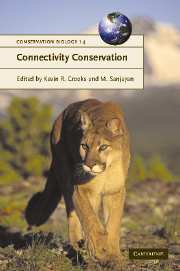Book contents
- Frontmatter
- Contents
- List of contributors
- Acknowledgements
- 1 Connectivity conservation: maintaining connections for nature
- PART I Approaches to connectivity research
- Introduction: Connectivity research—what are the issues?
- 2 Landscape connectivity: a return to the basics
- 3 Connectivity and metapopulation dynamics in highly fragmented landscapes
- 4 Genetics and landscape connectivity
- 5 Connectivity at the land–water interface
- 6 Influence of natural landscape fragmentation and resource availability on distribution and connectivity of gray wolves (Canis lupus) in the archipelago of coastal British Columbia, Canada
- 7 Migratory connectivity
- 8 Connectivity in marine ecosystems: the importance of larval and spore dispersal
- 9 Connectivity and wide-ranging species in the ocean
- 10 Hydrologic connectivity: a neglected dimension of conservation biology
- 11 Connectivity and ecosystem services: crop pollination in agricultural landscapes
- PART II Assessing connectivity
- PART III Challenges and implementation of connectivity conservation
- Index
- References
7 - Migratory connectivity
Published online by Cambridge University Press: 24 May 2010
- Frontmatter
- Contents
- List of contributors
- Acknowledgements
- 1 Connectivity conservation: maintaining connections for nature
- PART I Approaches to connectivity research
- Introduction: Connectivity research—what are the issues?
- 2 Landscape connectivity: a return to the basics
- 3 Connectivity and metapopulation dynamics in highly fragmented landscapes
- 4 Genetics and landscape connectivity
- 5 Connectivity at the land–water interface
- 6 Influence of natural landscape fragmentation and resource availability on distribution and connectivity of gray wolves (Canis lupus) in the archipelago of coastal British Columbia, Canada
- 7 Migratory connectivity
- 8 Connectivity in marine ecosystems: the importance of larval and spore dispersal
- 9 Connectivity and wide-ranging species in the ocean
- 10 Hydrologic connectivity: a neglected dimension of conservation biology
- 11 Connectivity and ecosystem services: crop pollination in agricultural landscapes
- PART II Assessing connectivity
- PART III Challenges and implementation of connectivity conservation
- Index
- References
Summary
INTRODUCTION
Migration represents one of the most complex and fascinating behaviors in nature. Simply defined, migration is the repeated movement of individuals from one region to another, and can occur over daily, seasonal, and annual time-frames. Migrations can occur over tens of thousand of kilometers, as in the case of the Arctic tern (Sterna paradisaea) moving essentially from pole to pole (Hatch 2002), or it can simply involve movements over distances as small as meters, as is the case of phantom midge larvae (Chaoborus spp.) moving from lake benthos during the day to the open water at night (Roth 1968). Migratory behavior has enormous taxonomic breadth including species of anadromous fish that leave natal rivers to spend several years at sea eventually returning to the same river to spawn and die (Hodgson and Quinn 2002), to the annual migrations of black rat snakes (Elaphe obsoleta) from winter hibernacula to summer breeding and foraging areas (Blouin-Demers and Weatherhead 2002), to the spectacular seasonal movements of long-distance migratory birds between temperate breeding and tropical winter environments (e.g., Keast and Morton 1980; Hagan and Johnston 1992). Movements such as these, by such taxonomically diverse groups of organisms, define migratory behavior and motivate the need to understand how these movements interact with and are modified by the physical structure of their environment.
For the majority of migratory birds, the spatial areas traveled are vast and the individuals too difficult to follow throughout the annual cycle.
Information
- Type
- Chapter
- Information
- Connectivity Conservation , pp. 157 - 183Publisher: Cambridge University PressPrint publication year: 2006
References
Accessibility standard: Unknown
Why this information is here
This section outlines the accessibility features of this content - including support for screen readers, full keyboard navigation and high-contrast display options. This may not be relevant for you.Accessibility Information
- 47
- Cited by
